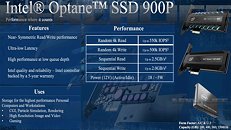Wednesday, October 11th 2017

Optane 900P SSD, Successor to the Intel 750 Series
"Industry contacts" have told TweakTown that a successor to Intel's well received 750 series NVMe drives will launch within weeks. The second generation Optane 900P SSDs will be available in both the U.2 and AIC (PCI-E 3.0) form factors, with capacities of 280, 480, 960 and 1500 GBs. Like the Intel 750 series, the Optane 900P has enterprise roots, namely Intel's ridiculously expensive 375GB P4800X; which we covered earlier. As the 900P is aimed at consumers, maybe more accurately prosumers, prices should be "affordable".Slide courtesy of TweakTown
Optane 900p
Source:
TweakTown
Optane 900p
- (Rumored) Sequential read/write speeds 2.5/2 GB/s
- (Rumored) Random IOPS read/write 550,000/500,000

31 Comments on Optane 900P SSD, Successor to the Intel 750 Series
I thought you need Intel 200-series at minimum to support Optane.
Active power consumption going up is not that big a surprise (we are supposedly getting better performance in return), but the idle numbers are real head-scratchers.
I'm not even sure random IOPS are that big an advantage even. I mean, the only quote is 500-550k, but even the 960EVO will do over 300k at QD32. It depends on which QD we get >500k IOPS.
But point taken.
Seriously ?
Of course, it's very pertinent to question the usefulness and value of something like this in the consumer space. I'm definitely passing on this one (not that I can fit one with my ITX motherboard, but I don't want one either :P ).
... most worthless PCIe extention card gets even less worthy successor.
>Well Done Intel, thats what we needed...
I also think SSDs are overrated. The price of good capacity is crap. Some people want 10TB or more, but not the sluggish HDD speed. It's a decent middle ground. I think the only thing that hurts Optane is Kaby Lake requirements. The idea itself doesn't suck.